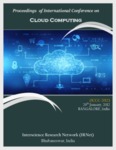

Published Date: 29-01-2012
Place of Conference: Bengaluru, India
Publisher: Institute for Project Management Pvt. Ltd.
DownloadProceeding of International Conference on Cloud Computing
ISBN 978-93-81693-17-9 Back
Editors
Prof.Srikanta Patnaik Mentor, IRNet India
About Conference
Cloud computing refers to computing with a pool of virtualized computer resources and is driven by economics of scale. A cloud can host a variety of different workloads, and allow workloads to be deployed and scaled-out quickly on-demand by rapid provisioning of virtual machines or physical machines. A cloud supports redundant, self-recovering, highly scalable programming models and allows workloads to recover from many unavoidable hardware/software failures. A cloud also monitors resource use in real time to enable rebalancing of allocations when needed. The idea is to move desktop computing to a service-oriented platform using server clusters and huge databases at datacenters. Cloud computing leverages its low cost and simplicity that benefits both users and the providers through providing cost-effective services and pay-per-use pricing model. In cloud computing, everything including software, platform, and infrastructure is as a service. Cloud computing makes data truly mobile and a user can simply access a chosen cloud with any internet-accessible device. Cloud computing overlaps some of the concepts of cluster, distributed, grid, service, ubiquitous, utility and virtual computing; however it has emerged from these computing domains and now has its own meaning. In cloud computing, a user does not care much what is in the cloud or what goes on there apart from being able to receive service from it. Cloud computing is now associated with a higher level abstraction of the cloud. Instead of there being application software, routers and servers, there are now services. The underlying hardware and software of networking is of course still there but there are now higher level service capabilities available to build applications. Hidden behind the services are data and computer resources. There have been many cloud computing platforms built so far including Google Cloud, IBM BlueCloud and Amazon Elastic Cloud. Programming models for cloud computing have been developed including MapReduce by Google and Hadoop by Yahoo group. Using these cloud computing models and toolsets, IT-related capabilities are provided as services, accessible without requiring detailed knowledge of the underlying technology. Of course, many mature technologies are used as components in cloud computing, but there are still many unresolved and open problems due to its unique characteristics which are different from distributed computing, cluster computing, grid computing, utility computing and service computing.

